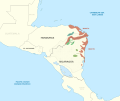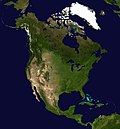Cacaopera is an extinct language belonging to the Misumalpan family, formerly spoken in the department of Morazán in El Salvador by the Cacaopera people...
4 KB (126 words) - 03:58, 15 June 2024
Salvadorans (category CS1 Spanish-language sources (es))
Cacaopera people are an indigenous people in El Salvador who are also known as the Matagalpa or Ulua. Cacaopera people spoke the Cacaopera language,...
55 KB (5,148 words) - 04:08, 21 August 2024
Only a few short word lists remain. It was closely related to the Cacaopera language. A timetable for a branch of the Jehovah's Witnesses on Big Corn Island...
10 KB (1,132 words) - 03:45, 9 August 2024
Miskito. Mayangna - dominant variety of the Sumo family Ulwa Matagalpan Cacaopera † – formerly spoken in the Morazán department of El Salvador; and Matagalpa...
14 KB (1,038 words) - 17:04, 27 May 2024
Salvador Cacaopera language, an extinct indigenous language in El Salvador This disambiguation page lists articles associated with the title Cacaopera. If...
261 bytes (64 words) - 18:48, 12 February 2019
The Cacaopera people also known as the Matagalpa or Ulúa., are an indigenous people in what is now El Salvador and Nicaragua. The Matagalpa are one of...
10 KB (1,059 words) - 18:04, 29 May 2024
Culture of El Salvador (category CS1 Spanish-language sources (es))
influences of Native American languages of El Salvador such as Lencan languages, Cacaopera language, Mayan languages and Pipil language, which are still spoken...
47 KB (5,548 words) - 05:36, 6 September 2024
spoken descendants. There are 14 languages listed, 7 lost in Central America and 7 lost in the Caribbean. Chorotega Cacaopera Chicomuceltec Lenca Matagalpa...
1 KB (68 words) - 18:47, 17 February 2023
the World's Languages: A Comparative Handbook, p. 471. (in press) "Homa". Ethnologue. "Manx". Ethnologue. "Moksela". Ethnologue. "Cacaopera". Ethnologue...
182 KB (6,349 words) - 08:40, 17 September 2024
century, and only few short wordlists remain. It was closely related to Cacaopera. The ethnic group, which numbers about 20,000, now speaks Spanish. Matagalpa...
1 KB (89 words) - 08:53, 9 April 2024
Matagalpa (category CS1 Finnish-language sources (fi))
Matagalpa was originally an indigenous village. The Cacaopera people, or Matagalpa had their own language, which has been extinct since 1875. A document from...
15 KB (1,232 words) - 00:43, 19 August 2024
Nawat (academically Pipil, also known as Nahuat) is a Nahuan language native to Central America. It is the southernmost extant member of the Uto-Aztecan...
31 KB (2,817 words) - 17:37, 5 September 2024
Ulwa language is in another sub-branch. The Matagalpan branch of Misumalpan contains two languages that are now extinct: Matagalpa and Cacaopera. The...
12 KB (971 words) - 02:56, 18 September 2024
Mayangna people (section Mayangna language)
Misumalpan language family, to which the Mayangna languages belong and which also includes Miskito and the extinct Matagalpan and Cacaopera tongues once...
21 KB (2,854 words) - 21:27, 27 August 2024
Salvadoran Lenca (redirect from Chilanga language)
Salvadoran Lenca or Potón is a language of the linguistic family of the Lenca languages spoken in El Salvador; and of which two dialects have been described:...
9 KB (696 words) - 19:02, 24 April 2024
The Lencan languages are a small linguistic family from Central America, whose speakers before the Spanish conquest spread throughout El Salvador and...
17 KB (1,452 words) - 09:58, 30 April 2024
indigenous language, also known as Chʼortiʼ, is a survival of Classic Choltian, the language of the inscriptions in Copan. It is the first language of approximately...
7 KB (560 words) - 10:35, 2 May 2024
Central America. They historically spoke various dialects of the Lencan languages such as Chilanga, Putun (Potón), and Kotik, but today are native speakers...
27 KB (3,382 words) - 00:31, 31 August 2024
Mestizo (category CS1 Spanish-language sources (es))
mostly of Lenca, Cacaopera, and Pipil descent are still present in El Salvador in several communities, conserving their languages, customs, and traditions...
86 KB (9,583 words) - 17:51, 15 September 2024
Indigenous languages Indigenous languages European language dialects Pidgin languages Indigenous languages Creole languages Indigenous languages Indigenous...
19 KB (145 words) - 18:21, 24 June 2024
Indigenous peoples of the Americas (category CS1 Spanish-language sources (es))
and Pacific areas and they are self-identified as follows: Chorotega, Cacaopera (or Matagalpa), Xiu-Subtiaba, and Nicarao. Indigenous peoples of Panama...
241 KB (24,706 words) - 12:25, 18 September 2024
Pipil people (category CS1 Spanish-language sources (es))
Nawat language, which belongs to the Nahuan language branch of the Uto-Aztecan language family. The Nawat language is distinct from the Nahuatl language, as...
36 KB (4,389 words) - 02:56, 16 September 2024
List of pre-Columbian cultures (category CS1 Spanish-language sources (es))
Miskito people, -1700 AD, Nicaragua Mayangna people, 1700 AD, Nicaragua Cacaopera people, 1700 AD, Nicaragua Indigenous peoples of the Americas portal Mississippi...
15 KB (1,091 words) - 02:07, 6 July 2024
claim that some codices did exist but have since disappeared. Their Nawat language, art and temples revealed that they had significant Mayan and Toltec influence...
22 KB (2,686 words) - 21:15, 9 August 2024
Nicarao people (category CS1 Spanish-language sources (es))
neighboring tribes including the Cacaoperas, the Chorotegas, and the Huetares. The Nicarao also enslaved and captured Cacaoperas for human sacrifice and further...
37 KB (3,082 words) - 07:15, 4 July 2024
Demographics of El Salvador (redirect from Languages of El Salvador)
of Maya peoples: (Poqomam people/Chorti people), Cacaopera people, Xinca people, and Mangue language people. The number of indigenous people in El Salvador...
78 KB (7,139 words) - 01:05, 10 September 2024
List of countries by ethnic groups (category CS1 Austrian German-language sources (de-at))
such as citizenship/nationality, ancestry or origin, country of birth, or language are used as alternative indicators. The data in the list are also of variable...
94 KB (1,256 words) - 18:14, 12 September 2024
Salvadoran cuisine (category Articles with Spanish-language sources (es))
such as the Lenca, Pipil, Maya Poqomam, Maya Chʼortiʼ, Alaguilac and Cacaopera peoples and some African influences. Many of the dishes are made with...
12 KB (1,462 words) - 17:04, 18 September 2024
Crime in El Salvador (category CS1 Spanish-language sources (es))
Sonsonate 11,621 33 23 30 17 4 11 118 284.0 197.9 258.2 146.3 34.4 94.7 169.2 Cacaopera Morazán 11,507 2 1 4 4 2 3 16 17.4 8.7 34.8 34.8 17.4 26.1 23.2 Chapeltique...
61 KB (3,703 words) - 06:54, 17 September 2024
and 1986. El Salvador has a dance called "Negritos de Cacaopera" (in Spanish: blacks of Cacaopera). In Ereguayquin, in the Department of Usulután, there...
16 KB (1,805 words) - 00:21, 4 May 2024





















